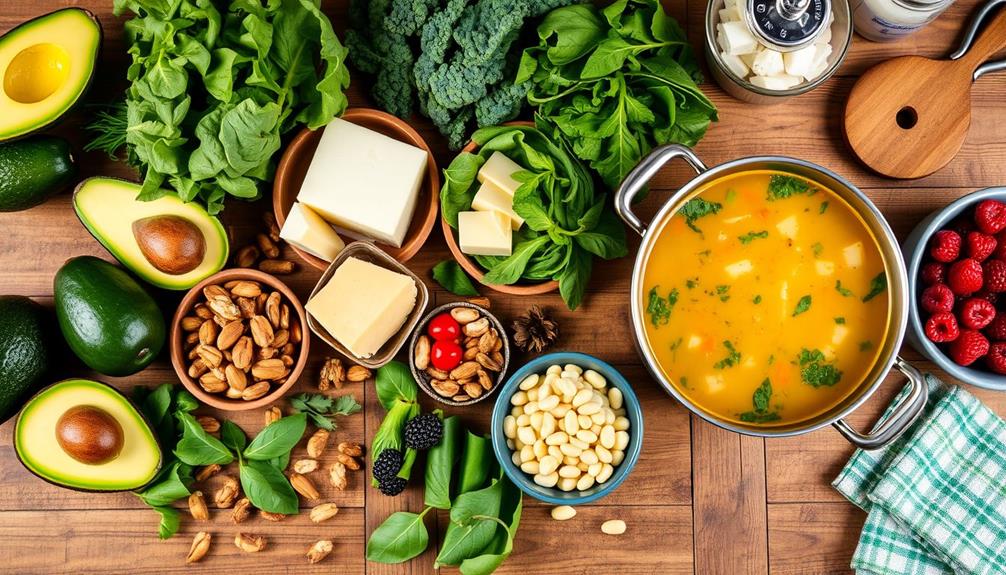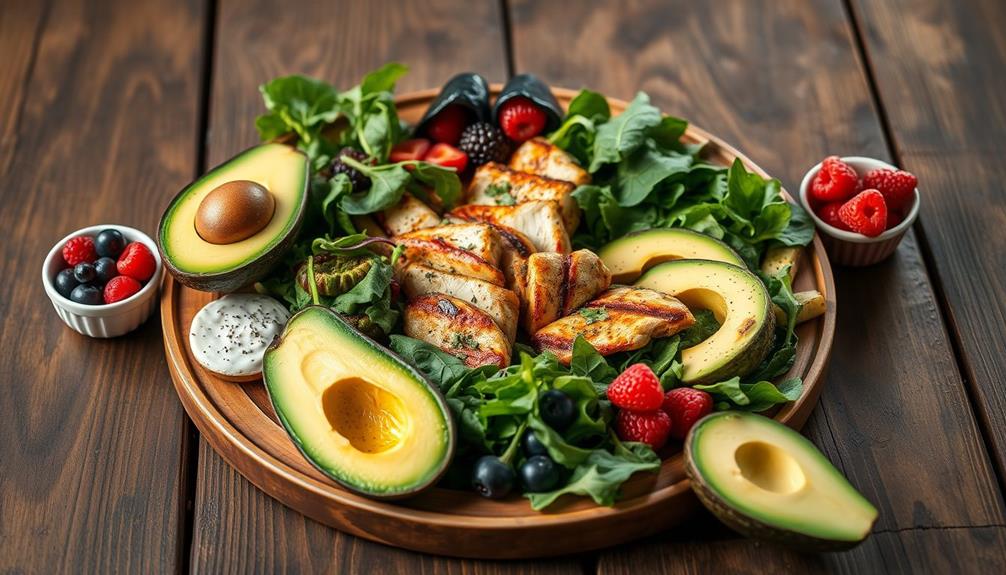To follow the keto diet, you need to cut your carbohydrate intake to about 20-50 grams daily. This helps your body enter ketosis, where it turns fat into energy. Focus on high-fat foods like avocados, fatty meats, and full-fat dairy. Incorporate low-carb veggies like spinach and broccoli while avoiding grains, starchy vegetables, and sugary snacks. Meal planning is essential to keep you on track, so prep your meals in advance. Remember to stay hydrated and replenish electrolytes to help manage any side effects. There's a lot more to explore about meal ideas and tips to guarantee success. Tracking keto progress is important to see how your body responds to the diet and to make any necessary adjustments. Keep a food diary to monitor your daily carb intake and ensure you’re staying within the recommended range. Additionally, consider tracking other factors such as energy levels, mood, and weight fluctuations to get a comprehensive view of your keto journey. If you’re looking for a more relaxed approach to the keto diet, you might consider “dirty keto.” This version allows for processed and low-quality foods as long as they fit within your carbohydrate limit. While this may seem convenient, it’s important to remember that the focus of the keto diet should still be on whole, nutritious foods for overall health and well-being. Tracking your progress and staying mindful of your food choices are still crucial, even with the flexibility of dirty keto explained.
Key Takeaways
- Focus on a macronutrient ratio of 70-80% fat, 15-25% protein, and 5-10% carbohydrates to achieve ketosis.
- Limit daily carbohydrate intake to 20-50 grams to effectively induce and maintain ketosis.
- Prioritize high-fat foods like avocados, fatty meats, and dairy while avoiding grains and sugary snacks.
- Prepare meals in advance using keto-friendly recipes to avoid temptation and manage portion control.
- Stay hydrated and maintain electrolyte balance to mitigate potential side effects during the transition to a keto diet.
Understanding the Keto Diet
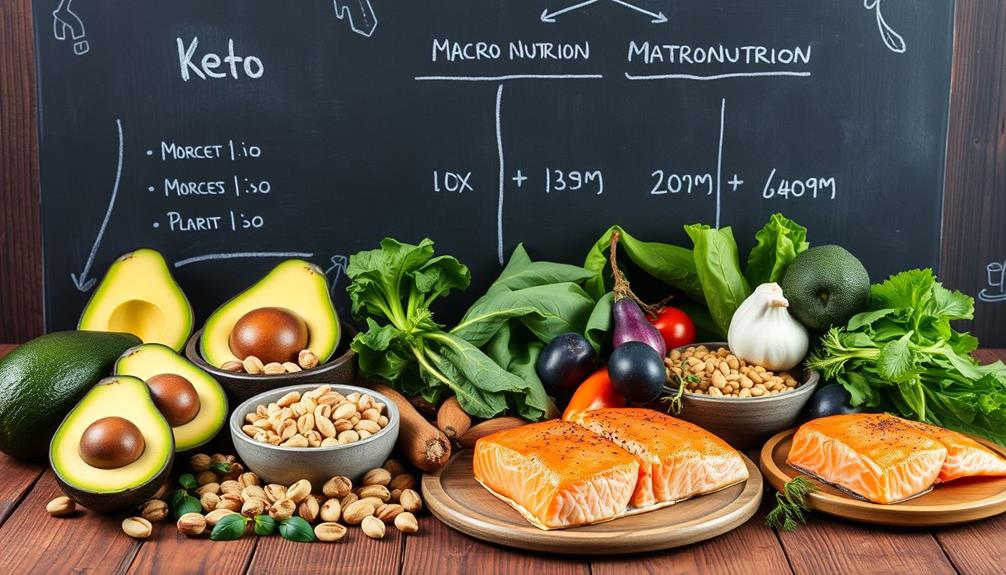
The ketogenic diet, often referred to as keto, revolves around a unique macronutrient composition: 70-80% fat, 15-25% protein, and just 5-10% carbohydrates. This low carb approach limits your carbohydrate intake to about 20-50 grams per day, helping your body enter a metabolic state known as ketosis.
In ketosis, your body shifts from using glucose as its primary energy source to burning fat, producing ketones that serve as an alternative fuel, particularly for your brain. Additionally, it's important to take into account how certain foods, like celery juice, can complement your high-fat diet by providing hydration and digestive benefits.
Originally developed in the 1920s for managing epilepsy, the keto diet has surged in popularity for weight loss. However, initial weight loss might be attributed to water loss rather than fat loss. To effectively follow a ketogenic diet, you'll need to be meticulous with meal planning and monitor your macronutrient intake.
This means focusing on high-fat foods like avocados, nuts, seeds, dairy, and fatty fish, while strictly avoiding grains, sugars, and most fruits. Understanding these dietary restrictions is essential, as they'll help you maintain nutritional ketosis and achieve your weight loss goals.
Essential Foods for Keto
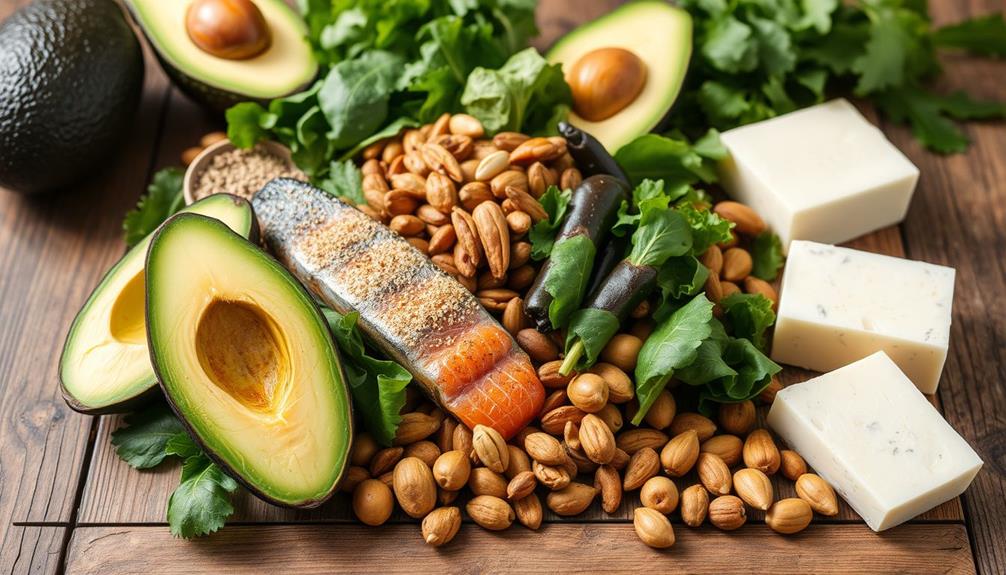
Mastering the essentials of a ketogenic diet can make all the difference in your journey toward better health. To thrive on a high-fat diet, focus on incorporating healthy fats and essential proteins. A balanced keto diet not only helps with weight management but also supports overall health effective strategies for weight loss.
Here's what you should include in your meals:
- Avocados: Packed with healthy fats, they're perfect for adding creaminess to your dishes.
- Fatty Cuts of Meat: Ribeye steak, pork belly, and chicken thighs will boost your protein intake while keeping your carbs low.
- Low-Carb Vegetables: Fill your plate with leafy greens like spinach and kale, and cruciferous options like broccoli and cauliflower for fiber and nutrients.
- Berries: Limit fruit intake to low-sugar options like strawberries and raspberries, which can satisfy your sweet tooth in moderation.
While enjoying these foods, remember to avoid foods high in carbohydrates, such as grains, sugary snacks, and starchy vegetables.
Sticking to these essential foods will help you maintain ketosis and support your health journey on keto diets. With the right choices, you'll find it easier to meet your goals and enjoy a satisfying, flavorful ketogenic diet.
Foods to Avoid
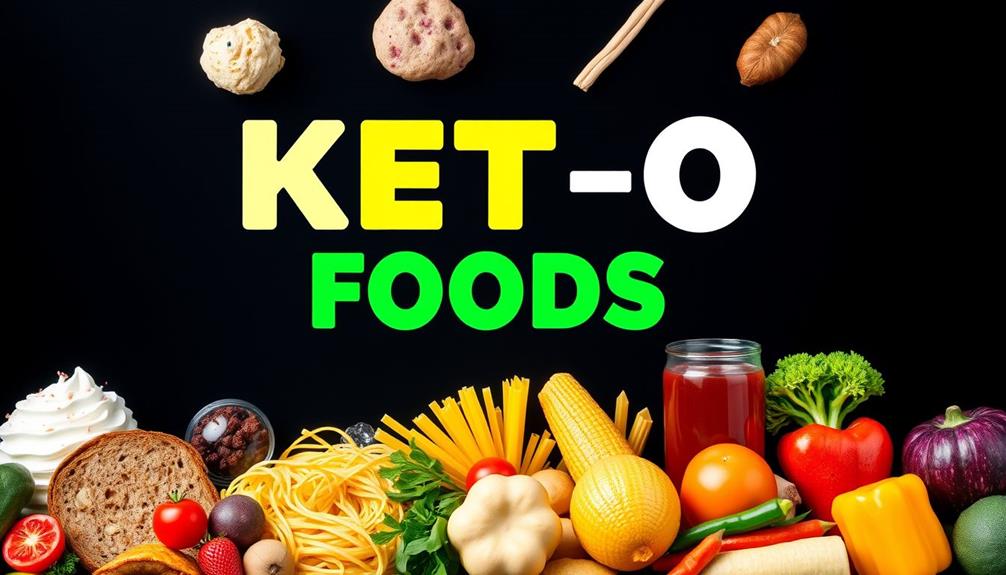
When you're following a keto diet, it's essential to avoid high-carb foods that can throw you off track. Sugary snacks and starchy vegetables not only pack on the carbs but can also spike your blood sugar levels.
Additionally, being mindful of your food choices can help you manage other health aspects, such as reducing uric acid levels for those prone to gout foods beneficial for managing gout symptoms.
High-Carb Foods
Guiding the ketogenic diet means steering clear of high-carb foods that can derail your progress toward ketosis. Staying within the daily carb limit of 20-50 grams is essential for maintaining the fat-burning state you aim for.
Understanding common financial terms can also provide clarity when budgeting for your diet, as it may require reallocating funds to healthier options.
Here are some high-carb foods you should avoid:
- Grains: Wheat, rice, and pasta can easily exceed your carb limit.
- Starchy vegetables: Potatoes, carrots, corn, and peas are loaded with carbohydrates.
- Fruits: Most fruits are high in sugar, with the exception of berries like strawberries and raspberries.
- Processed snacks: Chips, crackers, and cookies often contain hidden sugars and refined carbs.
Eliminating these high-carb foods will help you avoid spikes in blood sugar levels and keep your body in ketosis.
Remember, sugar-laden items like sodas and fruit juices are also off-limits. By steering clear of these items, you can focus on enjoying lower-carb options that support your ketogenic journey.
Make these adjustments, and you'll be on your way to a successful keto diet!
Sugary Snacks
To maintain your success on the ketogenic diet, it's important to steer clear of sugary snacks, which can quickly sabotage your progress. These treats, like candy, chocolate bars, and cookies, are loaded with high amounts of carbohydrates and can easily exceed your daily limit of 20-50 grams.
Additionally, understanding breast cancer symptoms can help keep your health in check while you focus on your diet. Be cautious with beverages too; sodas and fruit juices are major sources of sugar that cause rapid spikes in blood glucose, hindering ketosis.
Processed snacks, including chips and granola bars, often hide refined carbohydrates and hidden sugars, making them unsuitable for your keto lifestyle. Desserts made with flour, sugar, or starchy ingredients, like cakes and pastries, should also be avoided to help maintain a low carbohydrate intake and promote fat burning.
Even seemingly healthy options can be deceptive. Yogurt and some protein bars may contain added sugars, so it's essential to read labels carefully.
Instead, opt for low-carb alternatives that align with your ketogenic goals. By being mindful of what you consume, you'll stay on track and enjoy the benefits of your keto journey.
Starchy Vegetables
Avoiding starchy vegetables is essential for anyone committed to the ketogenic diet. These vegetables, like potatoes, corn, peas, and sweet potatoes, are high in carbohydrates, which can disrupt your efforts to achieve and maintain ketosis.
Individuals with emotional dysregulation, such as those with BPD, may find it particularly challenging to adhere to strict dietary guidelines due to fluctuating moods. To stick to the recommended carbohydrate intake of 20-50 grams per day, you need to steer clear of these starchy options.
Here are some starchy vegetables to avoid:
- Potatoes (one medium potato has about 37 grams of carbs)
- Corn (one cup of cooked corn contains around 31 grams of carbs)
- Sweet potatoes
- Peas
Instead, consider incorporating low-carb vegetable alternatives into your meals. Leafy greens, zucchini, and cauliflower are excellent choices that align with your ketogenic diet goals.
They help you maintain ketosis without exceeding your daily carb limit. By making these substitutions, you can enjoy delicious and satisfying meals while keeping your carbohydrate intake in check.
Meal Planning Strategies

Planning your meals is essential for staying on track with a keto diet. Start by prioritizing meal prep and crafting weekly menus that focus on high-fat, low-carb ingredients like avocados, fatty fish, and low-carb vegetables.
Understanding the impact of different ingredients on your diet can be helpful; for instance, certain brewing methods can enhance your coffee experience without adding unnecessary carbs. This helps guarantee you stay within your daily carb limits of 20-50 grams.
Create a shopping list that emphasizes keto-friendly foods such as meats, eggs, dairy, nuts, and oils while avoiding high-carb items like bread, pasta, and sugary snacks.
Utilize online resources and keto cookbooks to discover diverse recipes that keep your meals interesting and prevent dietary monotony. Batch cooking is a great strategy; store your meals in portioned containers to make access to nutritious, keto-compliant options quick and easy, especially on busy days. This reduces the temptation to stray from your diet.
Don't forget healthy snacks! Keep keto-friendly options like cheese, nuts, and olives on hand to manage hunger between meals and curb cravings for high-carb foods.
Managing Side Effects

Meal prepping can set you up for success, but managing the initial phase of a keto diet often comes with challenges, commonly referred to as "keto flu." Symptoms like fatigue, headache, and nausea can arise as your body adjusts to lower carbohydrate levels.
To help alleviate these discomforts, focus on proper hydration and electrolyte intake. Additionally, keeping your environment clean can help you feel better overall, as poor air quality can exacerbate feelings of fatigue and discomfort; consider an air purifier maintenance plan to enhance your indoor air quality.
Here are some tips to manage side effects effectively:
- Stay hydrated: Drink plenty of water to combat dehydration, especially since the keto diet can increase water loss.
- Boost electrolytes: Increase your intake of sodium and potassium to maintain electrolyte balance.
- Incorporate high-fiber vegetables: These can help reduce constipation, a common issue due to decreased fiber intake.
- Transition gradually: Slowly reduce carbohydrate intake rather than making abrupt changes to ease your body into ketosis.
If you're still experiencing persistent side effects or signs of insufficient ketosis, like constant fatigue, consider adjusting your macronutrient ratios or consulting a healthcare professional for personalized guidance.
Taking these steps can greatly improve your experience on the keto diet.
Health Benefits of Keto
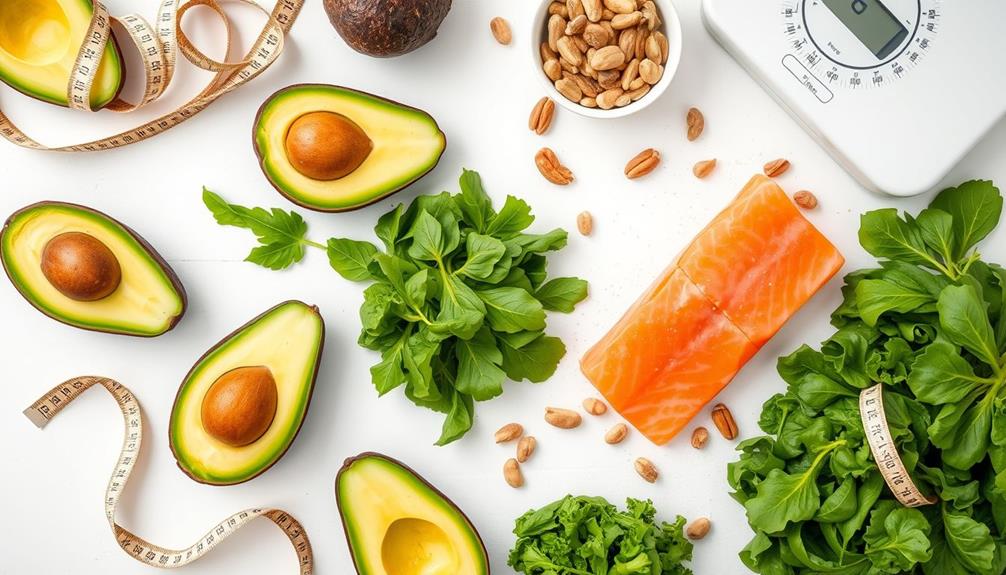
The ketogenic diet offers a range of health benefits that can greatly enhance your well-being. One of the most notable advantages is significant weight loss; many individuals lose an average of 2 pounds more than those on traditional low-fat diets within the first few months.
If you have type 2 diabetes, you'll be pleased to know that research shows about 60% of participants experience improved blood sugar control, with some even reversing their condition. Additionally, understanding tax implications of dietary choices can also play a role in overall health management strategies.
As your body adapts to the keto lifestyle, you might notice increased energy levels and mental clarity. This occurs as your body shifts from burning carbohydrates to utilizing fat for fuel, providing a steady energy source.
Additionally, the ketogenic diet has shown potential in reducing seizure frequency in epilepsy patients who don't respond well to conventional treatments.
Health benefits extend to your heart health too; studies indicate that the keto diet can improve cholesterol levels by lowering triglycerides and raising HDL cholesterol.
Long-term Considerations
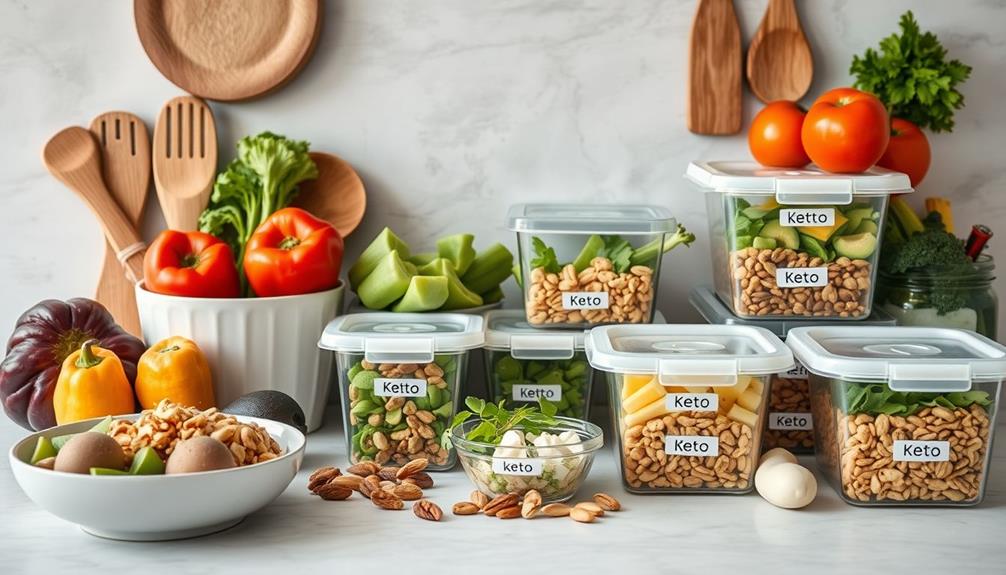
Many people overlook the long-term considerations of the ketogenic diet, which are essential for maintaining health and weight loss success. While the keto diet can lead to short-term weight loss, it's important to think about how it fits into your overall lifestyle in the long run.
Additionally, understanding financial considerations for elderly care can help you plan for future health-related expenses that may arise as you age.
- Monitor for nutrient deficiencies due to the restrictive diet.
- Schedule regular cholesterol checks to assess heart health.
- Be aware of potential weight regain after moving away from keto.
- Embrace continuous nutrition education for informed choices.
Moving away from keto without a balanced approach can lead to weight regain, as many find it challenging to reintroduce carbohydrates without overindulging.
It's also essential to recognize that keto isn't a permanent solution; instead, consider it for specific medical conditions or short-term weight loss.
Afterward, aim for a sustainable eating pattern that includes a variety of foods to prevent nutrient deficiencies.
Incorporating consistent nutrition education into your regimen can empower you to make healthier decisions and maintain your long-term weight loss goals.
Tips for Success
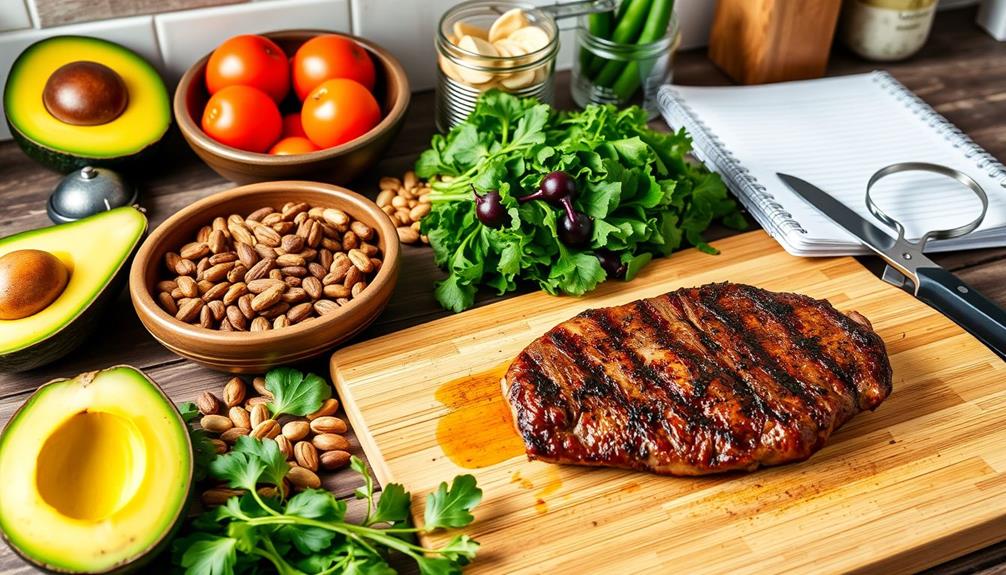
To succeed on the keto diet, you need effective meal planning strategies to keep your meals balanced and aligned with your goals.
Staying hydrated is essential, too, so make sure you're replenishing electrolytes as you adjust to this new way of eating.
With these tips in mind, you can make your keto journey smoother and more enjoyable.
Meal Planning Strategies
Effective meal planning is essential for success on the keto diet, helping you stay within your carb limits while enjoying delicious foods. To make your meal prep strategies effective, focus on incorporating high-fat foods and low-carb vegetables into your daily meals.
You'll want to guarantee adequate fat intake while keeping your carb limit between 20-50 grams per day.
Here are some tips to get you started:
- Plan meals around high-fat foods like avocados, nuts, and fatty fish.
- Prepare bulk meals in advance to avoid temptation from high-carb processed foods.
- Read food labels carefully to identify hidden carbohydrates that could sabotage your efforts.
- Stock up on keto-friendly snacks such as cheese, hard-boiled eggs, and nuts to keep cravings at bay.
Staying Hydrated Properly
Staying properly hydrated is essential on the keto diet, as your body tends to lose more water and electrolytes during this change. Aim for at least 3-4 liters of water daily to combat dehydration.
Maintaining your electrolyte balance is vital; consider supplementing with sodium, potassium, and magnesium. This can help alleviate symptoms of the "keto flu" and keep your hydration levels in check.
Incorporate electrolyte-rich beverages, like bone broth or sugar-free electrolyte drinks, into your routine to replenish lost minerals. Additionally, keep an eye on the color of your urine—light yellow indicates good hydration, while darker shades suggest you need to up your fluid intake.
Don't forget about hydrating foods! Leafy greens and avocados are excellent choices that not only provide hydration but also essential nutrients to support your ketogenic lifestyle.
Resources for Support

Finding support while maneuvering the keto diet can make a significant difference in your journey. Engaging with others who share similar goals not only provides motivation but also valuable resources.
Here are some ways you can tap into various forms of support:
- Online platforms: Join dedicated keto groups on Reddit or Facebook where you can share your experiences, recipes, and tips.
- Educational resources: Explore websites like Diet Doctor and Ruled.me for meal plans, recipes, and articles specifically tailored to the ketogenic lifestyle.
- Mobile apps: Use apps like Carb Manager and MyFitnessPal to assist in tracking your carbohydrate intake and monitor your macronutrient ratios.
- Professional guidance: Consult a registered dietitian who specializes in low-carbohydrate diets for personalized advice and nutritional balance.
Frequently Asked Questions
What Are the Basic Rules for Keto?
To succeed on keto, limit carbs to 20-50 grams daily. Focus on high-fat foods, moderate your protein intake, and stay hydrated. Avoid sugary items, grains, and most fruits, except for berries in moderation.
What Is the Right Way to Do Keto?
Picture a treasure map leading you to health; the right way to do keto involves charting your course with high-fat foods, tracking your intake, avoiding temptations, and staying hydrated to navigate smoothly through ketosis.
How Do I Start My Keto Diet for the First Time?
To start your keto diet, set your daily macronutrient goals around 70% fat, 20% protein, and 5-10% carbs. Plan meals ahead, focus on keto-friendly foods, and track your intake for best results.
How Long Should You Stay on a Keto Diet?
You might wonder how long to stick with keto. Most experts suggest 3 to 6 months for best results. After that, it's wise to reassess your diet and gradually shift to something more balanced.
Conclusion
To summarize, committing to the keto diet can create an enthralling change in your health and habits. By focusing on fantastic fats and forsaking forbidden foods, you'll foster a fulfilling lifestyle. Remember to plan your meals meticulously, manage minor side effects, and celebrate your successes along the way. With the right resources and resolve, you'll navigate this nutritional journey with newfound energy and enthusiasm. Embrace the keto lifestyle and enjoy the delicious discoveries it brings!
